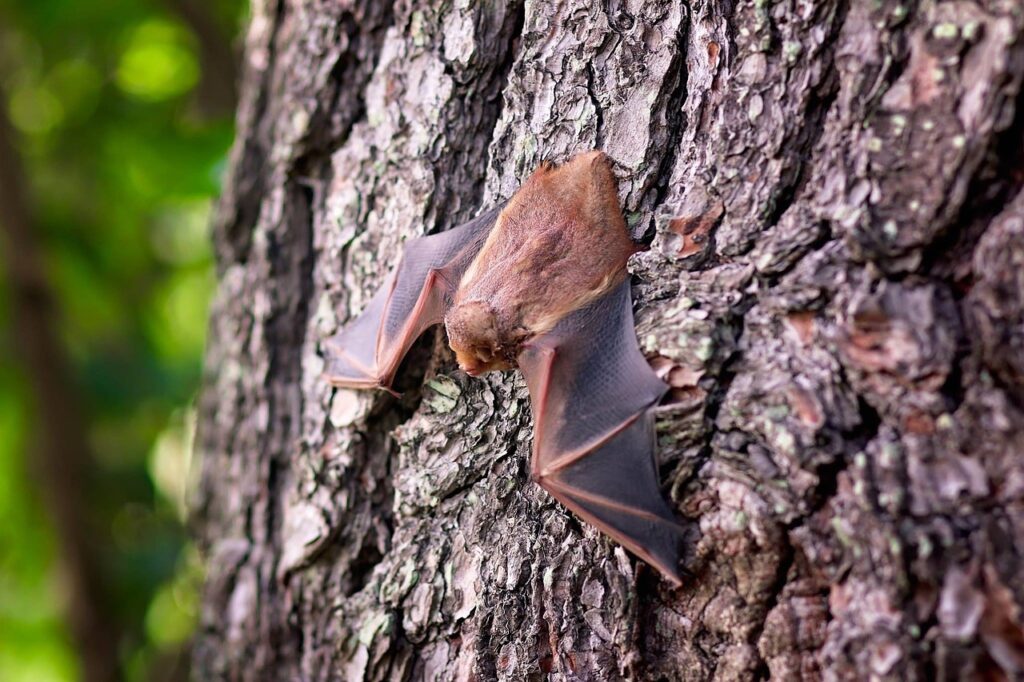Having good hearing is a useful trait for many animals. It allows them to hear potential threats long before they can see them. Smaller animals with limited speed depend on their senses to detect predators or prey.
Without this heightened sense of hearing, many smaller animals would be eaten or become a predator’s next meal. Having excellent hearing also aids in locating a mate, protecting cubs, and locating food sources. In this article, we will discuss animals with good hearing.
1. Common Vampire Bat

The common Vampire Bat (Desmodus rotundus) is a vampire bat species that feed on the blood of mammals, birds, and reptiles. It is found in Mexico, Central and South America, the Caribbean islands, and some parts of the United States. Common vampire bats are about 12 cm long with a wingspan of about 33 cm. They weigh about 20 grams.
The common vampire bat has a black coat, sometimes covered in white spots. Its ears are very large and can hear prey from a long distance away. The common vampire bat also has sharp teeth used for cutting through skin and sucking blood. These bats live in caves or abandoned mines where they sleep during the day before going out at night to feed on blood meals. They usually feed on cattle or horses but will bite humans if they feel threatened.
2. Barn Owl

Barn Owls are one of the most widely distributed birds in the world and can be found on every continent except Antarctica. These birds are nocturnal hunters with large eyes and a heart-shaped facial disk that helps funnel sounds towards their ears. Barn Owls have hearing similar to humans, which makes them great at locating prey at night.
The Barn Owl has excellent hearing, which allows them to locate prey in total darkness. This is because they have large eyes and ears which can sense low-frequency sounds. An owl’s ear has three parts: the outer ear, middle ear, and inner ear. The outer ear collects sound waves and sends them to the middle ear, amplified through tiny bones called ossicles (hammer, anvil, stirrup).
The sound travels into the inner ear, which is converted into nerve signals for processing by the brain. Barn Owls can hear higher
frequency sounds than humans because they have more sensitive outer ears than humans.
3. Wolf

The wolf has excellent hearing. The wolf’s sense of smell is so acute that it can detect a dead animal buried under a foot of snow and the remains of animals that have been dead for many days.
The wolf’s hearing aids in hunting and avoiding danger. A wolf can hear the footsteps of a deer or other prey over long distances, even through deep snow. It can also hear the sounds made by hunters, which allows it to run away before they get close enough to spot them.
Wolves communicate with one another through body language, scent marking, and howling. They can also communicate over long distances by howling in unison when separated.
4. Pigeon

Pigeons are a member of the bird family Columbidae, which includes about 310 species. The species is found naturally in most parts of North America, South America, and Europe. The pigeon has a long lifespan and can live up to 10 years. The birds weigh between 400 grams and 1 kilogram and measure about 30 cm in length.
The pigeon has excellent vision and hearing abilities, enabling it to see and hear from great distances. This enables it to detect predators from far away distances, allowing it to escape before being caught by predators. Pigeons have good eyesight because they have two foveae (eye spots),
located at the back of their head, close to their brain. These eye spots allow them to see even when flying at high speeds through dense forests or cities with tall buildings blocking their view of the ground below them.
Their hearing is also very sensitive because they have three different types of eardrums in each ear: lower, upper, and middle ear drums.
5. Gentoo Penguin

Gentoo penguins are one of the most abundant species of penguins in the world. They live in Antarctica and can be found on the Falkland Islands, South Georgia, and the South Sandwich Islands. Gentoos are medium-sized penguins generally found in open areas of the ice, where they can easily spot predators. Gentoo penguins have excellent hearing that allows them to catch very subtle sounds underwater. This
helps them identify predators that may be approaching from below.
In addition to their great sense of hearing, Gentoos also have a strong vision. They can see at night and during the day, which helps them spot predators from far away.
6. Humpback Whale

The humpback whale is the largest species of baleen whale. The humpback has a distinctive body shape, long pectoral fins, and a knobby head. Its upper parts are mostly black, but the flippers have white leading edges, and the underside is almost white in adults.
It also has an underbelly that is grey or pinkish. This coloration makes it harder for predators to see them when they are underwater.
The humpback whale’s flukes (tail) have between 10 and 13 grooves running along the underside. These grooves can identify individual whales. Fingerprints are used to identify humans. The humpback whale has acute hearing, which enables it to communicate over long distances underwater by clicking sounds.
They also use sound to communicate between individuals in social groups or pods that travel together for extended periods (called seasonal migrations).
7. Killer Whale

The killer whale has an incredible sense of hearing. This is because it has a very large brain, which is necessary for processing the information it receives through its ears. The killer whale’s hearing range is between 10 Hz and 100 kHz. This means that it can hear sounds at least ten times
lower than the human hearing range, which extends from 20 Hz to 20 kHz.
Killer whales have been known to use echolocation (echoes) to find their prey in the dark ocean depths. They produce a series of clicks in quick succession, which bounce off objects around them, then listen for returning echoes. They use these echoes to locate food or other things around
them.
8. African Elephant

Elephants have excellent hearing and can detect the high-pitched squeaks of other elephants, even over great distances. Elephants can also hear sounds that travel through the ground, such as thunder, volcanoes, and earthquakes. They have a large ear canal that houses many small hairs.
These hairs vibrate when they pick up sound waves and send signals to the brain via nerve cells. The Elephant‘s brain processes these signals into sounds. The African Elephant has two large ears on the sides of its head that are covered with long hair. The ears are large enough to cover the entire side of an adult elephant’s body. They help warm blood flow through them before it returns to the body, which keeps the animal cool in hot
climates.
9. Rat

Rats have large ears that are highly mobile, allowing them to pinpoint the location of a sound with great accuracy.
The rat‘s ear is complex and filled with tiny bones, muscles, nerves, and blood vessels. The outer ear comprises three parts:
- The pinna (the visible part of the ear)
- The external auditory meatus (the opening into the ear
canal) - The auditory canal itself
The inner ear contains fluid-filled chambers that amplify sound waves before they reach the brain through nerve fibers.
The rat’s middle ear includes three small bones called ossicles that transfer vibrations from the eardrum to the inner ear. The inner ear also has an outer and inner hair cell membrane which sends information from these hair cells to nerve fibers in the cochlea that carry signals to the
brainstem for interpretation.
10. Rabbit

Rabbits have very good hearing, and it’s not unusual for them to respond to noises humans can’t hear.
Rabbits are prey animals, so they have developed very good hearing, smell, and vision senses to stay alive. Their eyesight is excellent at night and in dim light, but their eyesight is poor in bright sunlight.
Their ears are on the sides of their head, giving them a wide hearing range. Rabbits can distinguish between different sounds from different directions and can tell the difference between similar-sounding words such as “yes” and “no.”
The eardrum vibrates when sound waves enter it. These vibrations travel through three small bones called ossicles (ossicles), which connect the eardrum with the inner ear (cochlea).
The inner ear contains fluid and tiny hairs that detect these vibrations. The hairs send signals to the brain through nerves, translating them into sounds we can understand.
A rabbit’s hearing is so sensitive that if you whisper in one ear while someone whispers in another ear, your bunny will be able to tell who whispered what.
11. Catfish

The catfish family of fish is well known for their excellent hearing capabilities. The catfish is one of the best hearing creatures on Earth. While this is no surprise to those who have watched a catfish in the wild, many people find it surprising that a fish can have such good
hearing.
Catfish have an incredibly sensitive ear structure that allows them to hear extremely low-frequency sounds. However, they are also able to hear higher frequency sounds as well.
This makes them extremely successful hunters as they can detect prey several meters away.
Catfish use their ears for many things, including hunting, communication, and navigation. They also use them to find their way around when swimming in murky waters or at night when visibility is low.
Catfish also use their ears for communicating with one another through vibrations in the water that travel through the air into your ear canal, where they can be detected by hair cells located there.
Wrapping Up
Animals with good hearing usually rely on their sense of order to identify and track down their prey. Different types of animals have other means of identifying marks. However, one commonality between most of the animals listed above is that they have extremely acute hearing and
exceptional eyesight. This combination allows for a full 360 degrees view, which gives them the advantage against prey.

